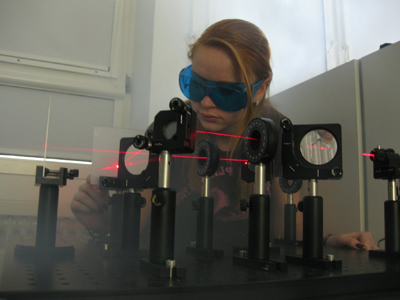On July 22, 14 hrs, the Department of Physics will open a new pupils laboratory. Students have conceived the five stations of the laboratory that is named “PSI – The Physics Pupils Laboratory Initiative”. The opening with a presentation of the laboratory and guided tours will take place at Kleiner Hörsaal 3 (A) der Physik (Engesserstraße 7, building 30.22) on the university campus.
During the past two and a half years, nine students of teaching developed experiments and adapted them to pupils within the framework of their state examination. Pupils can learn how to catch and move microobjects, e.g. starch cells, with the help of a laser beam, as if it was a pair of tweezers. They may construct a nitrogen laser and use it to generate microstructures in polymer foils. They may also construct a spectrometer and analyze light sources. And by combining coffee pots with photomultipliers, they can count natural particle radiation from the universe. In addition, they can use an interferometer to study properties of light particles (photons).
Professors Kurt Busch, Heinz Kalt, and Günter Quast supervised the students, Dr. Antje Bergmann supported them extensively. Presently, other students are working on new experiments for the laboratory or are extending existing experiments.
The pupils laboratory mainly addresses physics courses and individual, highly interested pupils of the schools’ higher grades. Up to ten young people can use the laboratory at the same time. Dates of vis-its and durations may be agreed upon individually, explains Antje Bergmann. On the PSI website “the pupils can prepare their experiments at the laboratory”, says Bergmann. There, they will find explanations of the physical fundamentals of the experiments in a form tailored to pupils. Animations will help to make the partly complicated physical matters understandable.
Dean Busch explains that the pupils laboratory is aimed at illustrating the significance and achievements of physical research. “From the coming school year, the pupils at the laboratory will experience fascinating areas of current physics – thus, we wish to arouse their interest in studies of engineering or natural sciences”, underlines Busch. According to Busch, the PSI shall complement physics lessons at school. It allows for “direct contact with the scientists and provides insight in the work performed at research institutions”.
Registration:
Dr. Antje Bergmann
Phone. +49 721/608-7643
E-mail: bergmann ∂does-not-exist.tfp uni-karlsruhe de
The Karlsruhe Institute of Technology (KIT) is the merger of the Forschungszentrum Karlsruhe, member of the Helmholtz Asso-ciation, and the Universität Karlsruhe. This merger will give rise to an institution of internationally excellent research and teaching in natural and engineering sciences. In total, the KIT has 8000 employees and an annual budget of 700 million Euros. The KIT focuses on the knowledge triangle of research – teaching – innovation.
The Karlsruhe institution is a leading European energy research center and plays a visible role in nanosciences worldwide. KIT sets new standards in teaching and promotion of young scientists and attracts top scientists from all over the world. Moreover, KIT is a leading innovation partner of industry.

